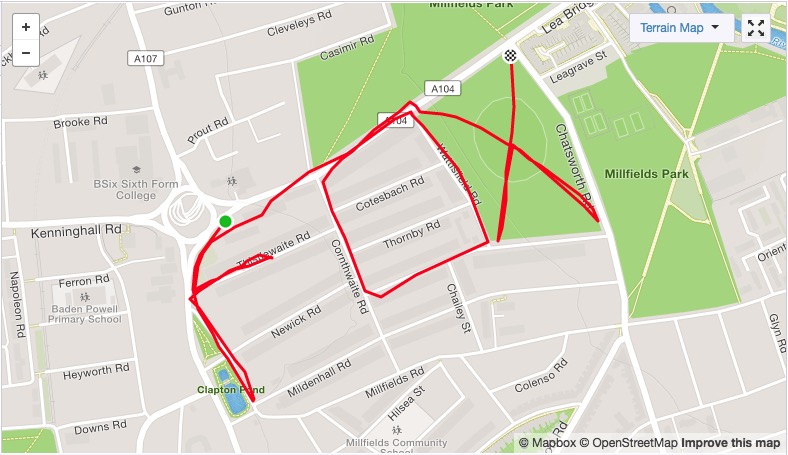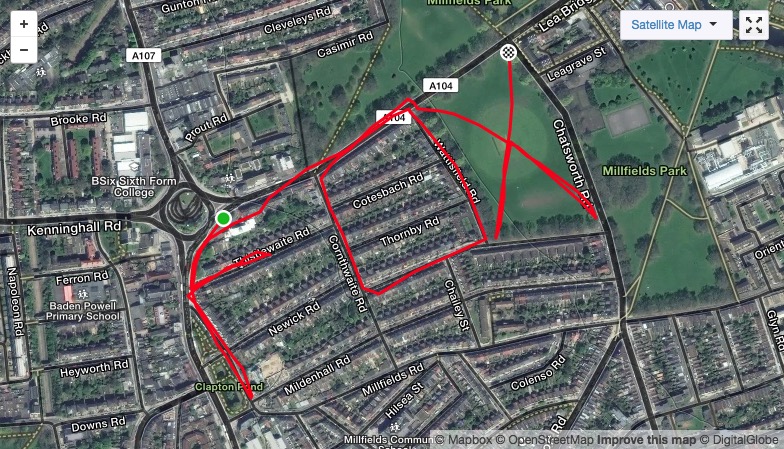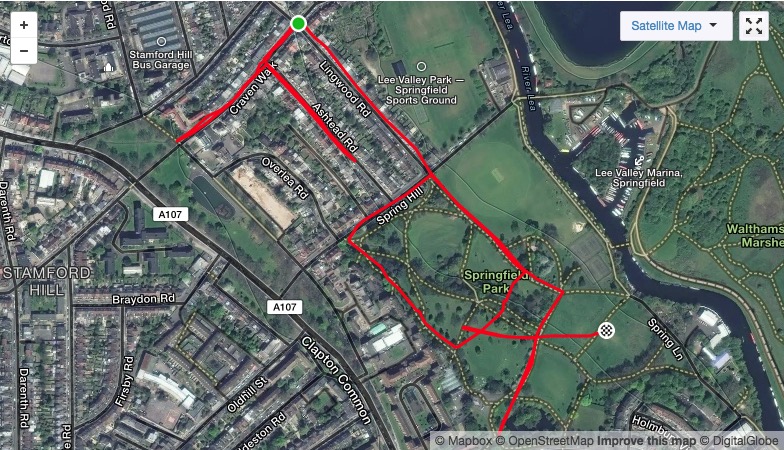Writing Letters to the Fox, 2018, Verónica Perales.
Writing Letters to the Fox
Writing / Drawing
El 15 de septiembre de 2019 un grupo de corredores en el Jardín Nacional de Atenas se reunió para “escribir”, “dibujar” juntos participando en la obra Writing Letters to the Fox. Esta acción colectiva, enmarcada en el Analogio Festival @analogiofestival inauguraba una pieza de narrativa sonora geolocalizada “Species in-between” (https://cgeomap.eu/ecap/).
La carrera, de unos 2km dibujaba en los caminos del National Garden, con un GPS, la palabra FOX. Yannis Ziogas, artista y director del Departamento de Bellas Artes de la Universidad d e Florina, encabezó el grupo invitando al público a correr con él.
“Lying down on the meadow I can hear the cow grazing nearby, it plucks the grass shoots from my head helping itself with its tongue. Wet caress and pulls, wet caress and pulls, huff and puff… the cow is. The cow is as the meadow. I am with the cow who is with the meadow.” Verónica Perales (2018)
On september 15th 2019 at the Zappeion / National Garden in Athens, take place a collective GPS-writing performance - group run “Writing Letters to the Fox “& a locative media walk for mobile devices “Species in-between” (https://cgeomap.eu/ecap/) curated by Geert Vermeire for Analogio Festival @analogiofestival.
A run of about 2 km to write the word FOX by running the paths of the National Garden, tracked by GPS, resulting in a GPS-text that is overlaying nature. The run was collective and leaded by Yannis Ziogas, artist / rector of the Department of Fine and Applied Arts, University of Florina, inviting the public to run with him.
“Tumbada en el prado oigo cerca la vaca pastando, arranca los brotes de hierba de mi cabeza con ayuda de su lengua. Caricia húmeda y tira, resopla. Caricia húmeda y tira, resopla... La vaca es. La vaca es con el prado. Yo soy con la vaca que es con el prado.” Verónica Perales (2018)
The encounter
During the last days of 2017 I started, in response to the terrible situation of foxes in Spain and, by extension, in other countries, a project that I placed under the motto “Writing letters to the fox”. I had been living in London since mid-December (for investigation purposes) and I began, as usual, to explore the area nearby my home. Running is a practice that helps me to stay in shape and allows me to get to know new places without losing the “human” scale when travelling from one place to another (I move forward to the extent of my physical abilities). I had seen some foxes hiding in small parks, isolated green areas in the middle of the city, but that morning after a rainy day I found a dead female fox on the sidewalk, in an urban transit area. I guess she was hit by a car, her hip was open and there was no trace of blood. The raindrops were trapped in her fur, indelible, like a gaze fixed on a stone wall. I spent a while by her side, taking advantage to examine her features, her expression, her body… in detail, to understand her. When I woke up on the morning of January 1st 2018, in the preamble before starting the first day of a new year, the image of the fox lying on the road came suddenly up to my mind, and I could see how her shape unfolded and the trace of her body—now without color mass, just drawing, just line— moved away from her cold body. She turned to look back and then she vanished like a sigh in the very street where we met. Every now and then her line comes to visit the papers in which I draw, as for me, I have started to write her letters (Writing letters to the fox) in the limits between the green and urban areas of the city, on the areas in which several of them “work their paw to the bone”.
El encuentro
Durante los últimos días de 2017 inicié como respuesta a la terrible situación de los zorros en España y por extensión en otros países, un proyecto que situé bajo el lema “Writting letters to the fox”. Llevaba viviendo en Londres desde mediados de diciembre (por una estancia de investigación) y empecé, como de costumbre, a explorar el terreno cercano a mi residencia. Salir a correr es una práctica que me ayuda a estar en forma y me permite conocer lugares sin perder la escala “humana” en los desplazamientos (me alejo en la medida de mis posibilidades físicas). Había visto algún zorro escondido en pequeños parques, zonas verdes aisladas en medio de la ciudad, pero aquella mañana después de un día de lluvia encontré a una zorra muerta en la acera, una zona urbana de paso. Imagino que había sido atropellada, tenía la cadera abierta y no había restos de sangre. Las gotas de lluvia habían quedado marcadas en su pelaje, indelebles, como la mirada fija sobre el muro de piedra. Me quedé un rato cerca de ella, aprovechando para observar en detalle sus rasgos, su gesto, su cuerpo... para aprehenderla. Al despertar la mañana del 1 de enero de 2018, en ese preámbulo antes de empezar el primer día de un nuevo año, me sobrevino la imagen de la zorra en la calzada, y vi como su figura se desdoblaba y el trazo de su cuerpo -ahora sin masa de color, sólo dibujo, sólo línea-, se alejaba del cadáver frío. Se giró para mirar atrás y se perdió como una nota en la misma vía en la que nos encontramos. El trazo de la zorra viene de vez en cuando a visitar los papeles en los que dibujo, yo por mi parte, empecé a escribirle cartas (Writting letters to the fox) en los límites entre las zonas verdes y las urbanas de la ciudad, esas zonas en las que muchos de ellos “dejan su piel”.




The writing/drawing on the map is a reivindication of the space, a “squatting” of it, a “tag”. “FOX” like stitches of thread or sewing, like conjunctions that seek to repair the fractures that are created among natural spaces and spaces entirely conquered by human activity. FOX like a sort of “lettering” with GPS.
The main cause of death for urban foxes in the United Kingdom is being hit by a car. Foxes are animals with a long life expectancy (over fifteen years), but in urban areas they rarely live longer than two years, it is estimated that in London they live between fourteen and eighteen months. Foxes in Spain are not that lucky, it seems like we are not so willing to give up space and competitions are organized to hunt adult foxes and offspring with the aim of reducing, year after year, its population. Nonhuman animals have no say and even less a “vote”, it is our answer after having ignored the question. We turn abruptly and deafeningly (emotional anesthesia) before that bond of energy that connects us to the ground and the sentient reply: all animals have their own languages, and they leave their marks and voices on the territory, even if humans cannot hear them (Desblache, 2011).
La escritura/dibujo sobre el mapa es una reivindicación del espacio, una oKupación del mismo, un “tag” . “FOX” como puntadas de hilo o costuras, como conjunciones que pretenden reparar las fracturas que se generan entre espacios naturales y espacios enteramente conquistados por la actividad humana. FOX como una suerte de “lettering” con GPS. La causa más común de muerte de zorros urbanos en el Reino Unido es el atropello con coches. Los zorros son animales bastante longevos (alrededor de quince años), pero en las urbes raramente superan los dos años de edad, en Londres se estima que entre catorce y dieciocho meses. En España los zorros no gozan de la misma suerte, parece que no estamos tan dispuestos a ceder espacio y se organizan concursos para cazar adultos y crias con el objetivo de mermar, año tras año, la población. Los animales no humanos no tienen voz y mucho menos "voto", es nuestra respuesta tras haber desoído la pregunta; hacemos un giro brusco y ensordecedor (anestesia emocional) antes de que ese vínculo energético que nos une a la tierra y lo sintiente nos replique: all animals have their own languages, and they leave their marks and voices on the territory, even if humans cannot hear them (Desblache, 2011).
Verónica Perales, Writing Letters to the Fox (2018)



